Matrices and Determinants | Mathematics - Exercise 7.5: Choose the correct answer | 11th Mathematics : UNIT 7 : Matrices and Determinants
Chapter: 11th Mathematics : UNIT 7 : Matrices and Determinants
Exercise 7.5: Choose the correct answer
Matrices and Determinants (Mathematics)
Choose the correct or the most suitable answer from the given four alternatives.
(1) If aij
= 1/2 (3i − 2j ) and A = [a ij] 2×2
is
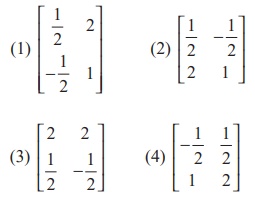
Ans: (2)
Solution

(2) What must be the
matrix X, if
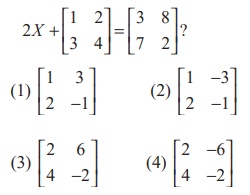
Ans: (1)
Solution
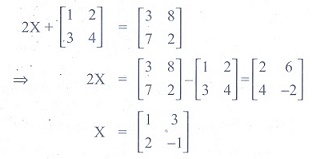
(3) Which one of
the following is not true about the matrix 
(1) a scalar
matrix
(2) a diagonal
matrix
(3) an upper triangular
matrix
(4) a lower triangular
matrix
Ans: (2)
(4) If A and B are two
matrices such that A + B and AB are both defined, then
(1) A and B are two
matrices not necessarily of same order
(2) A and B are square
matrices of same order
(3) Number of columns of
A is equal to the number of rows of B
(4) A = B.
Ans: (2)
Solution
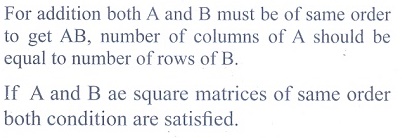
(5) If A =  ,
then for what value of λ, A2 = O ?
,
then for what value of λ, A2 = O ?
(1) 0
(2) ±1
(3) - 1
(4) 1
Ans: (2)
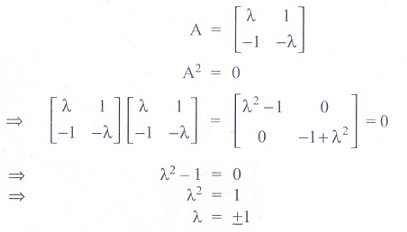
(6) If  and
( A + B )2 = A2 + B2 then the values of a
and b are
and
( A + B )2 = A2 + B2 then the values of a
and b are
(1) a = 4, b = 1
(2) a = 1, b = 4
(3) a = 0, b = 4
(4) a = 2, b = 4
Ans: (2)
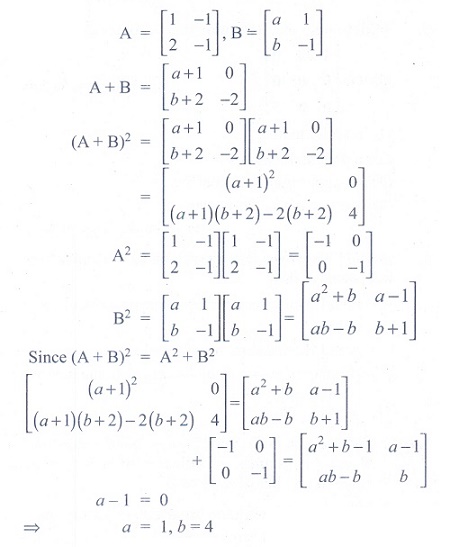
(7) If  is a matrix satisfying the equation AAT = 9I, where I is 3 × 3
identity matrix, then the ordered pair (a, b) is equal to
is a matrix satisfying the equation AAT = 9I, where I is 3 × 3
identity matrix, then the ordered pair (a, b) is equal to
(1) (2, - 1)
(2) (- 2, 1)
(3) (2, 1)
(4) (- 2, - 1)
Ans: (4)
Solution
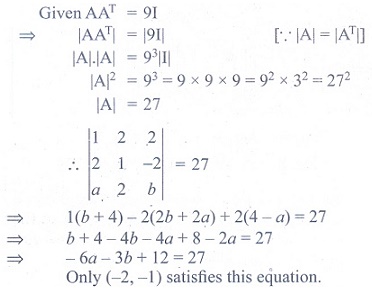
(8) If A is a square
matrix, then which of the following is not symmetric?
(1) A + AT
(2) AAT
(3) ATA
(4) A − AT
Ans: (4)

(9) If A and B are
symmetric matrices of order n, where ( A ≠ B), then
(1) A + B is
skew-symmetric
(2) A + B is symmetric
(3) A + B is a
diagonal matrix
(4) A + B is a zero
matrix
Ans: (2)
Solution

(10) If A =  and if xy = 1, then det ( AAT ) is equal to
and if xy = 1, then det ( AAT ) is equal to
(1) (a −1)2
(2) (a2 +1)2
(3) a2
−1
(4) (a2 −1)2
Ans: (4)
Solution

(11) The value of x, for
which the matrix A =  is singular is
is singular is
(1) 9
(2) 8
(3) 7
(4) 6
Ans: (2)
Solution
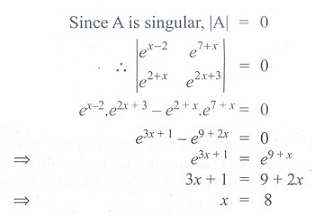
(12) If the points (x,
−2), (5, 2), (8,8) are collinear, then x is equal to
(1) - 3
(2) 1/3
(3) 1
(4) 3
Ans: (4)
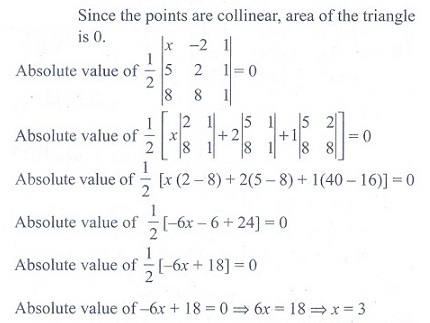
(13) If  = abc/2 ≠ 0, then the area of the triangle whose
vertices are
= abc/2 ≠ 0, then the area of the triangle whose
vertices are  is
is
(1) 1/4
(2) 1/4abc
(3) 1/8
(4) 1/8 abc
Ans: (3)
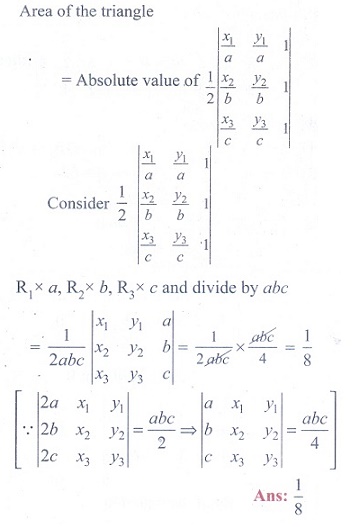
(14) If the square of
the matrix  is the unit matrix of order 2, then α, β and γ should
satisfy the relation.
is the unit matrix of order 2, then α, β and γ should
satisfy the relation.
(1) 1+ α2 +
βγ = 0
(2) 1− α2 −
βγ = 0
(3) 1− α2
+ βγ = 0
(4) 1+ α2
− βγ = 0
Ans: (2)
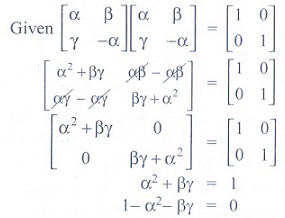
(15) If  is
is
(1) ∆
(2) k∆
(3) 3k∆
(4) k3∆
Ans: (4)

(16) A root of the
equation  = 0 is
= 0 is
(1) 6
(2) 3
(3) 0
(4) - 6
Ans: (3)
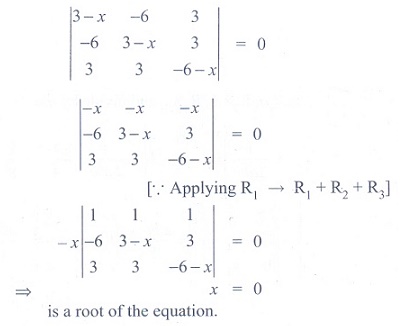
(17) The value of
the determinant of A =  is
is
(1) - 2abc
(2) abc
(3) 0
(4) a2 + b2
+ c2
Ans: (3)

(18) If x1
, x2 , x3 as well as y1 , y 2 , y3
are in geometric progression with the same common ratio, then the points (x1
, y1 ), (x2 , y2 ), (x3 , y3)
are
(1) vertices of an
equilateral triangle
(2) vertices of a
right angled triangle
(3) vertices of a
right angled isosceles triangle
(4) collinear
Ans: (4)
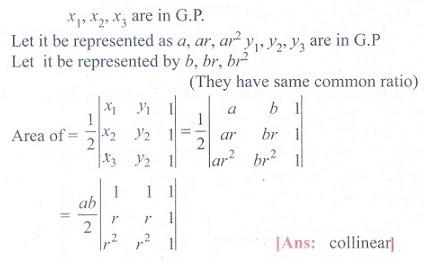
(19) If ![]() denotes the greatest integer less
than or equal to the real number under consideration and −1 ≤ x < 0, 0
≤ y < 1, 1 ≤ z < 2 , then the value of the determinant
denotes the greatest integer less
than or equal to the real number under consideration and −1 ≤ x < 0, 0
≤ y < 1, 1 ≤ z < 2 , then the value of the determinant  is
is

Ans: (1)
Solution
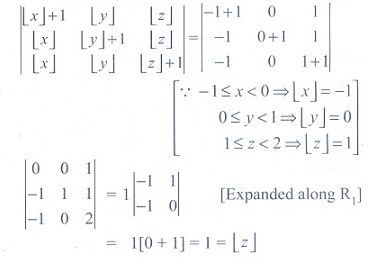
(20) If a ≠ b, b,
c satisfy  = 0, then abc =
= 0, then abc =
(1) a + b +
c
(2) 0
(3) b3
(4) ab + bc
Ans: (3)
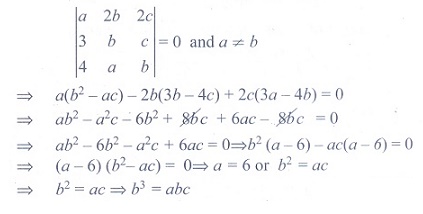
(21) If  , then B is given by
, then B is given by
(1) B = 4A
(2) B = − 4A
(3) B = − A
(4) B = 6A
Ans: (2)
Solution
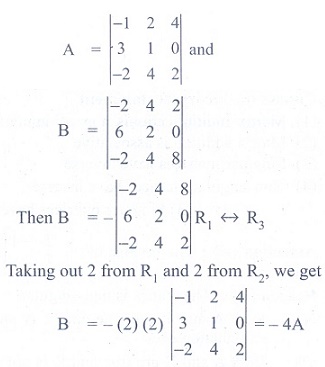
(22) If A is
skew-symmetric of order n and C is a column matrix of order n ×
1, then CTAC is
(1) an identity matrix
of order n
(2) an identity matrix
of order 1
(3) a zero matrix of
order 1
(4) an identity matrix
of order 2
Ans: (3)

(23) The matrix A
satisfying the equation  is
is

Ans: (3)
Solution
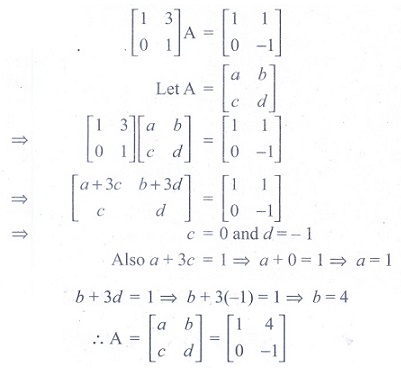
(24) If A+ I =  , then ( A+I )( A-I ) is equal to
, then ( A+I )( A-I ) is equal to
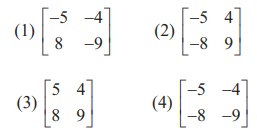
Ans: (1)
Solution
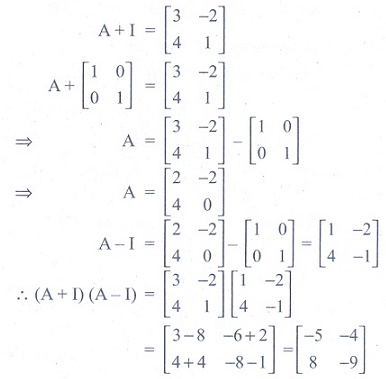
(25) Let A and B
be two symmetric matrices of same order. Then which one of the following
statement is not true?
(1) A + B is a symmetric
matrix
(2) AB is a symmetric
matrix
(3) AB = (BA)T
(4) ATB = ABT
Ans: (2)
Solution
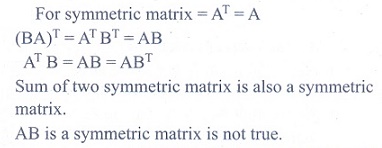
Related Topics